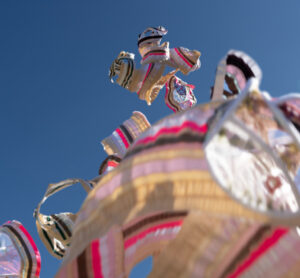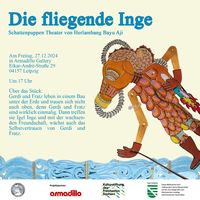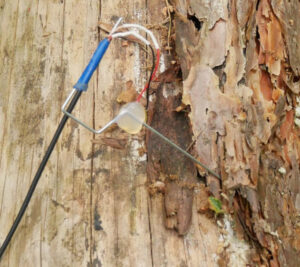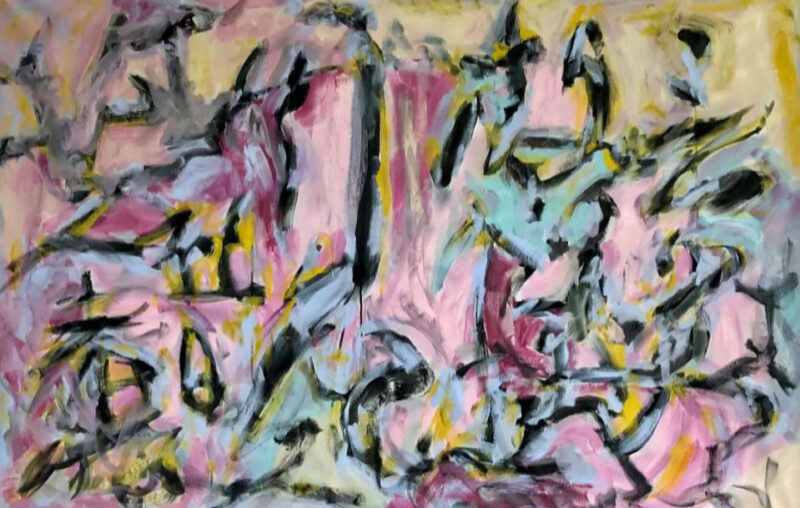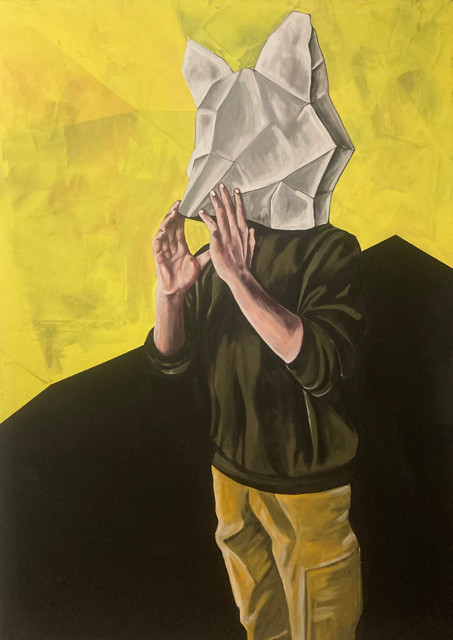
BODY LANDSCAPES in 2 acts
Ksenia Malurika Valeriia Burliuk Rina-Green Noodle
Anna Galeeva (concept curator, art historian, @anngaleeva)
Antje Görner (founder, director, TAKT curator and artist)
(2 Act) Dec 4 th 2025 5-8pm

The exhibition BODY LANDSCAPES in 2 acts, running from November 19 to December 19, 2025, unfolds as a two-act composition. The first act opens on November 19 (5–8 pm), the second on December 4 (5–8 pm). Featuring three artists, the exhibition is conceived as a theatrical structure — each act forming an autonomous scene, yet together they breathe as one, shaping a continuous landscape of visuality and perception.
Act I presents works by Ksenia Malurika, Rina-Green Noodle, and Valeriia Burliuk. In Malurika’s paintings, her pictorial and graphic language fuses abstraction and figuration, exploring how the body can be reassembled through gesture, line, and mark. In the Acceptation series — fragments of an ear, an eye, lips — the body becomes a topography of perception, a system of signs attuned to the movement of sound, breath, and gaze. Nearby, the works of Rina-Green Noodle evoke corporeal respiration through rug embroidery. In Clean Sound and New and My Fragile Happiness, fabric turns into a body that preserves traces of warmth and gesture; textile becomes a landscape born between touch and imagination. Valeriia Burliuk’s work within the first act deepens the sense of bodily fragmentation — proximity so intimate that the larger landscape dissolves into sensation. In the photograph Acceptance, the surface of skin becomes the horizon itself, a line where the boundary between human and space recedes. The body here is perceived as a field of interrelations, as the very space of seeing and breathing.
Act II presents a new body of photographs by Valeriia Burliuk alongside a single painting by Ksenia Malurika. In this part of the exhibition, the artist’s body — through photography and mixed media — literally becomes part of the landscape. In the Swimmer in the Grass series, it merges with the field, dissolving into air and light; in Stone, The Protagonist, and The Apogee, the body folds into the earth, echoing its contours, breathing with its rhythm. Here, photography transforms into a space of embodied experience — a form of spatial visuality where light and breath construct presence itself. This act connects with the moment we inhabit now: a time of transition, permeability, and quiet dissolution of borders. As Maurice Merleau-Ponty wrote, “We do not look at the world; we breathe within it.” In this sense, the body becomes not an image but a site of vision, an inner architecture of perception where each frame sounds like a breath.
The two acts can be perceived as scenes from a single play — akin to Samuel Beckett’s Endgame, where action arises through pauses, cycles, and the physicality of presence. In two acts, painting and photography exchange traces, inhabiting each other’s spaces. The result is a choreography of forms and atmospheres — a shared “body landscape” where the boundary between self and environment flows like the tide.
Ksenia Malurika, WEBSITE | FULL CV
Interdisciplinary artist, painter, performer, curator, her practice explores the intimate experience of being — within space, time, and body. The artist investigates presence as a fragile structure: always partial, shifting, ungraspable. Ksenia works with silence and pause, with embodied perception and memory. Through painting, performative actions and site-specific interventions she explores what it means to be here — now — with others — or alone. Practices painting, performative and site-specific installation, curatorial work, video, scenography.
Valeriia Burliuk, WEBSITE | FULL CV
Artist and Researcher for whom space is the most important medium: it breathes, reacts, and draws the viewer into a holistic experience. Her practice is structured as work with the environment — from photography which “unfolds” into installative objects, to bioart in which materiality and scientific processes become a language of expression. Her education and research activities (research fellow / guest artist at the Bauhaus University, Weimar) give her a perspective of precision and methodology, while her artistic intuition, poetry and physicality to this direction. In her photographic and installation projects, exhibition solutions, space functions as an organism in which sound, light, texture, temperature and rhythm interact to create a field of soft, engaging, tactile power that leads to clarity.
Rina-Green Noodle, WEBSITE | FULL CV
She is a textile artist working with reclaimed fabrics and worn materials, transforming them into tactile narratives that preserve traces of time. Her works reveal a dialogue between care and resilience, where material memory becomes a living language. A member of the European Textile Network and the Creative Union of Artists of Russia, she explores the emotional and ecological dimensions of textile practice, connecting the personal and the planetary. Drawing from traditions of rug hooking and hand embroidery, her pieces emerge as sculptural surfaces—woven stories of transformation, labor, and tenderness. Based in Moscow, she collaborates with institutions such as A2 Galerie (Potsdam), Zotov Center, and TEXTURA Gallery, continuously expanding the field of contemporary textile art through her material and poetic research.
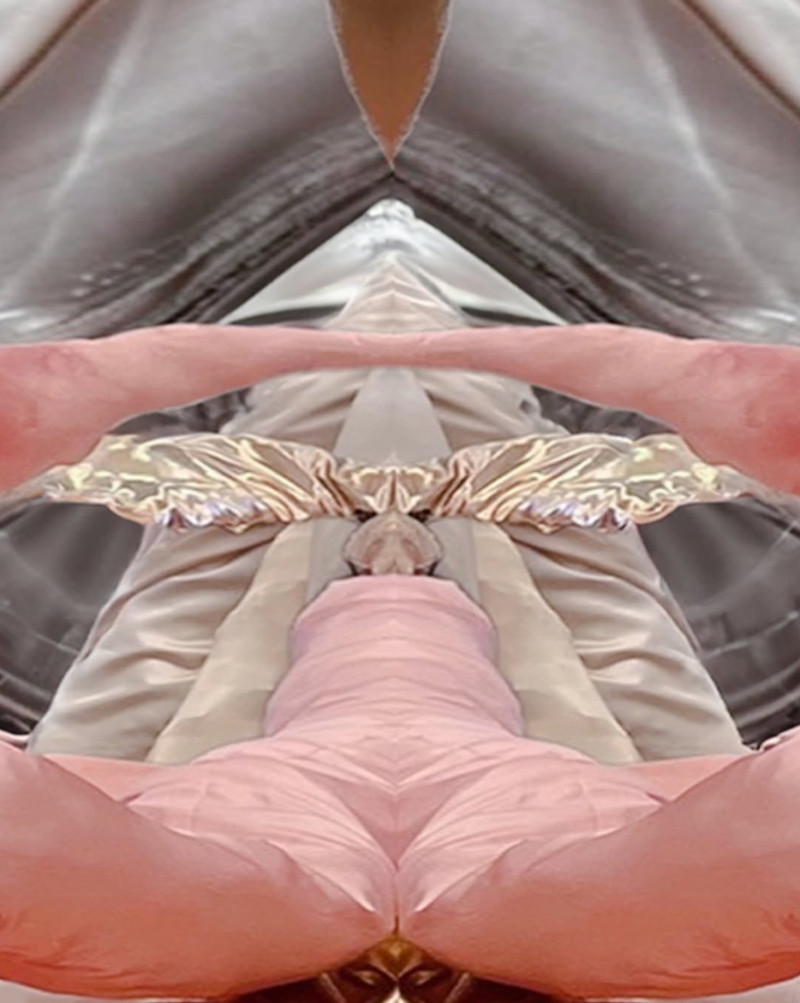

B ODY LANDSCAPES in 2 acts
Die Ausstellung BODY LANDSCAPES in 2 acts, die vom 19. November bis zum 19. Dezember 2025 zu sehen ist, entfaltet sich als zweigeteilte Komposition. Der erste Akt eröffnet am 19. November (17–20 Uhr), der zweite am 4. Dezember (17–20 Uhr). Drei Künstlerinnen gestalten eine Ausstellung, die wie eine theatrale Struktur aufgebaut ist – jeder Akt bildet eine eigenständige Szene, doch gemeinsam atmen sie als ein Ganzes und formen eine fortlaufende Landschaft der Wahrnehmung und der Sichtbarkeit.
Der erste Akt zeigt Arbeiten von Ksenia Malurika, Rina-Green Noodle und Valeriia Burliuk. In den Gemälden von Ksenia Malurika verschmelzen Abstraktion und Figuration; ihre Bildsprache untersucht, wie sich der Körper durch Gesten, Linien und Spuren neu zusammensetzen lässt. In der Serie Acceptation – Fragmente eines Ohres, eines Auges, von Lippen – wird der Körper zu einer Topografie der Wahrnehmung, zu einem System von Zeichen, das die Bewegung von Klang, Atem und Blick aufnimmt. In unmittelbarer Nähe entstehen die Werke von Rina-Green Noodle, die durch Teppichstickerei ein körperliches Atmen hervorrufen. In Clean Sound and New und My Fragile Happiness verwandelt sich Stoff in einen Körper, der Spuren von Wärme und Berührung bewahrt; das Textile wird zu einer Landschaft zwischen Tastsinn und Imagination. Die Arbeiten von Valeriia Burliuk im ersten Akt vertiefen das Gefühl körperlicher Fragmentierung – eine Nähe, so intensiv, dass sich die größere Landschaft in Empfindung auflöst. In der Fotografie Acceptance wird die Hautoberfläche selbst zum Horizont, zu einer Linie, an der sich die Grenze zwischen Mensch und Raum zurückzieht. Der Körper erscheint hier als Feld gegenseitiger Durchdringung – als Raum des Sehens und Atmens.
Der zweite Akt präsentiert neue Fotografien von Valeriia Burliuk zusammen mit einem Gemälde von Ksenia Malurika. In diesem Teil der Ausstellung wird der Körper der Künstlerin – durch Fotografie und Mixed Media – buchstäblich Teil der Landschaft. In der Serie Swimmer in the Grass verschmilzt er mit dem Feld, löst sich in Luft und Licht auf; in Stone, The Protagonist und The Apogee fügt sich der Körper in die Erde, folgt ihren Konturen, atmet in ihrem Rhythmus. Hier verwandelt sich die Fotografie in einen Raum verkörperter Erfahrung – eine Form räumlicher Visualität, in der Licht und Atem Präsenz erschaffen. Dieser Akt schwingt mit dem Moment, in dem wir uns befinden: einer Zeit des Übergangs, der Durchlässigkeit, des leisen Auflösens von Grenzen. Wie Maurice Merleau-Ponty schrieb: „Wir betrachten die Welt nicht – wir atmen in ihr.“ So wird der Körper weniger zum Bild als zu einem Ort des Sehens, zu einer inneren Architektur der Wahrnehmung, in der jedes Bild wie ein Atemzug klingt.
Die beiden Akte lassen sich als Szenen eines einzigen Stücks begreifen – verwandt mit Samuel Becketts Endspiel, in dem Handlung aus Pausen, Zyklen und der Körperlichkeit des Daseins entsteht. In zwei Akten tauschen Malerei und Fotografie Spuren aus, bewohnen gegenseitig ihre Räume. Das Ergebnis ist eine Choreografie von Formen und Atmosphären – eine gemeinsame „Körperlandschaft“, in der die Grenze zwischen Selbst und Umgebung so fließend ist wie die Gezeiten.
![]()
![]()
Etkar-André-Str. 29, 04157 Leipzig

